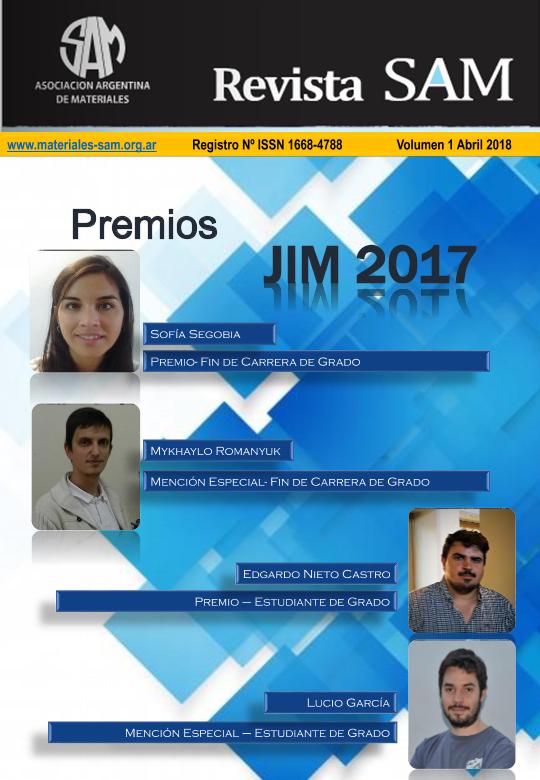Mostrar el registro sencillo del ítem
dc.contributor.author
Segobia, Sofía
dc.contributor.author
Sommadossi, Silvana Andrea

dc.date.available
2020-09-18T19:41:30Z
dc.date.issued
2018-04
dc.identifier.citation
Segobia, Sofía; Sommadossi, Silvana Andrea; Transformaciones de fases sólido-sólido en el sistema al-ni. parte II; Asociación Argentina de Materiales; Revista SAM; 2018; 1; 4-2018; 4-9
dc.identifier.issn
1668-4788
dc.identifier.uri
http://hdl.handle.net/11336/114338
dc.description.abstract
Uno de los sistemas que pertenece a las superaleaciones es el de Aluminio-Níquel. El objetivo de este trabajo es profundizar el análisis de sus fases intermetálicas (FIs) de mayor contenido de Ni, a 1000 y 1170°C, las cuales poseen atractivas características tecnológicas y diversas aplicaciones a nivel industrial. El proceso de Unión por Transición de Fase Líquida (Transition Liquid Phase Bonding, TLPB) permite obtener uniones de alta estabilidad mecánica y térmica, resistentes a la corrosión, y la formación de capas intermetálicas (CIs)/FIs de buena adhesividad con el sustrato, mediante procesos de difusión-reacción. Las CIs de mayor contenido de Ni crecen consumiendo a las capas de mayor contenido de Al. La secuencia es Al/C1/C2/C3/C4/C5/Ni, siendo C1: Al3Ni, C2: Al3Ni2, C3: AlNi-rica en Al, C4: AlNi-pobre en Al y C5: AlNi3. Se realizaron estudios de morfología, cinética, composición química y comportamiento mecánico, utilizando técnicas de microscopía óptica, electrónica (SEM-EDS) y microdureza Vickers, en C3, C4 y C5 con extensos tratamientos térmicos (TT). La capa C3 presentó una morfología porosa, disminuyendo su espesor a costa de C4 y un acelerado crecimiento de C5. C4 evidenció a ambas temperaturas una morfología lisa y otra martensítica, donde C4-martensita se consumió en última instancia a costa de C5. A ambas temperaturas y extensos TT, creció una fase de morfología porosa que llamamos C5-Superior. Los resultados de composición química y de dureza evidenciaron que la misma, es similar a C5 y se correlaciona con AlNi3. El estudio cinético reportó que a 1000°C, las capas C4 y C5 tienen un crecimiento parabólico controlado por difusión. A 1170°C, C4 creció con un control por reacción en la interface, mientras que C5, cambió la modalidad parabólica de crecimiento cuando desapareció C3, incrementando sustancialmente su constante de crecimiento. Los valores de microdureza Vickers disminuyeron con el incremento del contenido de Ni, a ambas temperaturas.
dc.description.abstract
One of the systems belonging to the superalloys is Nickel/Aluminum. The aim of this work is to deepen the analysis of this superalloy’s inter-metallic phases (IPs) of higher Ni content, at 1000 and 1170°C, which have attractive technological characteristics and diverse industrial applications. The Transition Liquid Phase Bonding (TLPB) process allows obtaining joints with higher thermal and mechanical stability, corrosion resistance, and formation of inter-metallic layers (ILs)/IPs of good adhesion to the substrate through diffusion-reaction processes. The ILs with the highest Ni concentration grow by consuming the layers with the highest content of Al. The sequence is Al/L1/L2/L3/L4/L5/Ni, being L1: Al3Ni, L2: Al3Ni2, L3: AlNi(Al rich), L4: AlNi(Al poor) and L5: AlNi3. Morphology, kinetics, chemical composition and mechanical behavior studies were performed, using optical and electronic microscopy (SEM/EDS) and Vickers micro-hardness techniques in layers L3, L4 and L5 under extensive thermal treatments (TT). Layer L3 presented a porous morphology, decreasing its thickness at the expense of L4 and an accelerated growth of L5. L4 showed a smooth and a martensitic morphology at both temperatures, where L4-martensite was ultimately consumed at the expense of L5. A phase of porous morphology that we called L5- Superior, grew at both temperatures and extensive TT. The results of chemical composition and micro-hardness showed that it is similar to L5 and correlates with AlNi3 phase. The kinetic study reported that L4 and L5 exhibit parabolic growth, controlled by diffusion, at 1000 °C. L4 grew, controlled by interface reaction, at 1170°C, while L5 changed the parabolic growth when L3 disappeared, increasing its growth rate constant. Vickers micro-hardness values decreased with Ni concentration at both temperatures.
dc.format
application/pdf
dc.language.iso
spa
dc.publisher
Asociación Argentina de Materiales
dc.rights
info:eu-repo/semantics/openAccess
dc.rights.uri
https://creativecommons.org/licenses/by-nc-sa/2.5/ar/
dc.subject
TLPB
dc.subject
PARES DE DIFUSIÓN
dc.subject
Ni-Al
dc.subject
INTERMETÁLICOS
dc.subject.classification
Ingeniería de los Materiales

dc.subject.classification
Ingeniería de los Materiales

dc.subject.classification
INGENIERÍAS Y TECNOLOGÍAS

dc.title
Transformaciones de fases sólido-sólido en el sistema al-ni. parte II
dc.type
info:eu-repo/semantics/article
dc.type
info:ar-repo/semantics/artículo
dc.type
info:eu-repo/semantics/publishedVersion
dc.date.updated
2019-10-23T20:49:22Z
dc.journal.volume
2018
dc.journal.number
1
dc.journal.pagination
4-9
dc.journal.pais
Argentina

dc.journal.ciudad
San Nicolás
dc.description.fil
Fil: Segobia, Sofía. Universidad Nacional del Comahue; Argentina
dc.description.fil
Fil: Sommadossi, Silvana Andrea. Universidad Nacional del Comahue; Argentina. Consejo Nacional de Investigaciones Científicas y Técnicas. Centro Científico Tecnológico Conicet - Patagonia Norte. Instituto de Investigación En Tecnologías y Ciencias de la Ingeniería. Universidad Nacional del Comahue. Instituto de Investigación En Tecnologías y Ciencias de la Ingeniería; Argentina
dc.journal.title
Revista SAM
dc.relation.alternativeid
info:eu-repo/semantics/altIdentifier/url/http://materiales-sam.org.ar/sam/wp-content/uploads/2018/07/Revista-SAM-Vol-1-2018.pdf
dc.relation.alternativeid
info:eu-repo/semantics/altIdentifier/url/http://materiales-sam.org.ar/sam/revista-sam/
Archivos asociados
